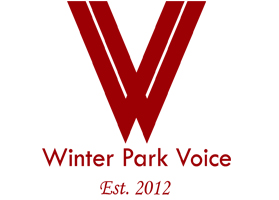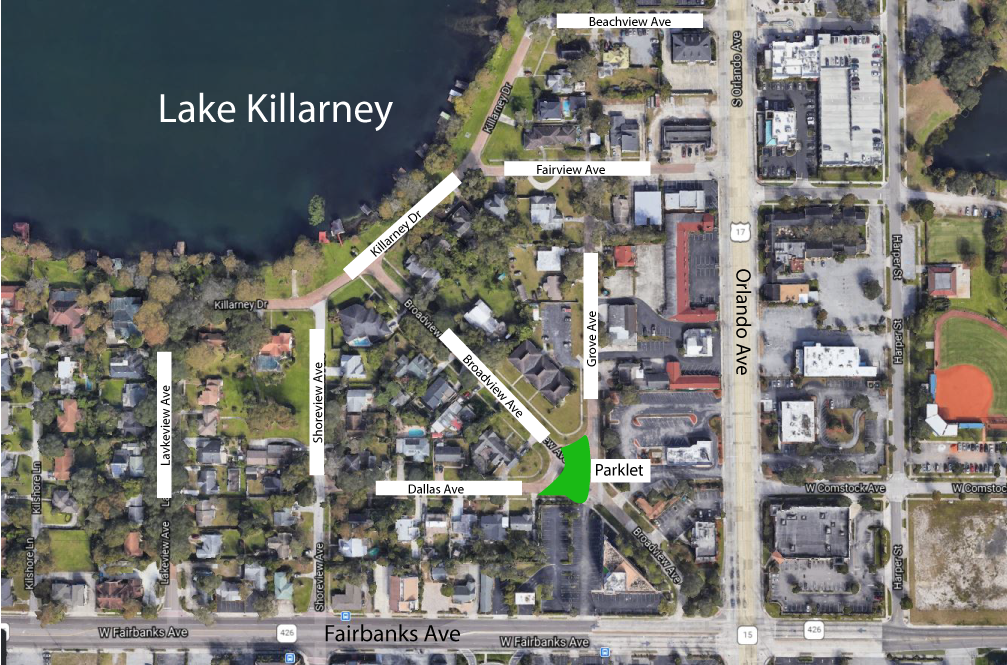Killarney Estates – No Longer the ‘Forgotten Triangle’
Can the City Reunite the Neighborhood?
In late January, plans to build the Henderson Hotel in the triangle bordered by 17-92, Fairbanks Avenue and Lake Killarney, known as Killarney Estates, ran headlong up against Comprehensive Plan Policy 1-J-9, which reads, “Protect Single-Family Residential Use in the Killarney Neighborhood from Non-Residential Land Use Encroachment. The City shall preserve and protect the single-family residential land use within the Killarney neighborhood from commercial and office encroachment . . . .”
Just before midnight on January 27 — before the Commission could vote on Commissioner Marty Sullivan’s motion to deny – attorney for developer Adam Wonus withdrew the application to build the hotel. It was Game Over.
Killarney Neighborhood’s cut-through traffic
Despite the outcome for the Henderson, Adam Wonus’s two-year effort to win approval for his project produced some positive results for this neglected corner of Winter Park by shining a light on serious traffic problems and general infrastructure neglect by the City. For years, Killarney residents had been plagued by cut-through traffic trying to avoid the major intersection of 17-92 and Fairbanks Avenue, and the development of way-finding apps has only made matters worse as Waze and others direct drivers going from 17-92 to Fairbanks (or the reverse) through the back streets of the neighborhood.
City Planners to the rescue
When Adam Wonus began meeting with the Lake Killarney neighbors about his proposed hotel, they described their traffic woes and Wonus alerted City Planners to their need for help. Commissioners and City staff met with the neighbors and decided to field test a traffic barrier on the southern leg of the intersection of Killarney Dr. and Fairview Ave. The City also created a permanent physical separation of Grove Ave. from Dallas Ave. and Broadview Ave. Adam Wonus even paid for the planter bollards that formed the barrier at Killarney Drive and Fairview Ave.
The traffic calming measures worked, cut-through traffic has slowed to a trickle and most Killarney neighbors are living happily ever after.
Unintended Consequences – A Neighborhood Divided
The demise of the Henderson project, however, has left what would have been the commercial hotel property separated from the rest of the neighborhood. The successful measures to tame cut-through traffic in the residential area southwest of Fairview now separate that part of the neighborhood from the portion north and east of Fairview.
The northeast part of the neighborhood is a mix of residential, commercial and office, and part of it fronts on 17-92, but there are still residential lakefront parcels in that area which most of the Killarney neighbors and the all of the City Commission wish to protect from commercial development.
How to put the neighborhood back together?
At a special Commission meeting February 11, 2021, the Commission directed staff to come up with additional options to protect the residential lakefront property and to reintegrate those properties into the existing transportation network. City staff also has initiated negotiations with mapping companies to eliminate cut-through routes through the Killarney neighborhood.
Decisions on traffic solutions must be based on future land use
At the March 24 Commission meeting, Planning Department staff presented 12 possible solutions to the remaining traffic problems.
Commissioner Carolyn Cooper quickly pointed out how the cart may have gotten ahead of the horse. “There are very different possible traffic solutions, depending on what the land use is,” she said. “Before we talk about zoning, let’s talk about what future land use really makes sense on these five or six parcels. The traffic solution must be based on a resolution of future land use by this Commission.”
Commission agrees to future workshop to discuss future land use
Of the possible solutions to the traffic problems, the City’s first option describes measures that either are already in place or well into the planning stages. It includes the planter bollard barrier at Fairview and Killarney Dr., and a small park area that would cut off the connection between Broadview, Dallas and Grove Avenues. This area already has been cordoned off with temporary barriers and cones. The only thing missing was a funding source. To build the “parklet,” as it is called, the City had to find $165,000 in additional funds.
CRA or Parks Acquisition Fund?
Since the intersection of Broadview, Dallas and Grove falls within the CRA, money could come from CRA, or because it’s a ‘parklet,’ the money could come from the Parks Acquisition Fund.
Commissioner Sheila DeCiccio made a motion to move forward with this option, to leave the bollards as they are, build the ‘parklet’ with $165,000 from the Parks Acquisition Fund and to hold a workshop to discuss future land use and a more permanent traffic solution based on the future land use. Commissioner Todd Weaver seconded. Weaver amended the motion to add approximately $3,600 to reimburse Adam Wonus for the cost of the bollards, with a second from Commissioner Marty Sullivan.
The main motion, as amended, passed on a 5-0 vote.


More needs to be done about the Fairbanks, 17-92 traffic, especially when it backs up to Morse and one can’t even turn left onto 17-92. This is only going to get worse when the events center is completed.
A solution that benefits homeowners, enhances a residential neighborhood, creates parkland, and reduces cut-through traffic “passed on a 5-0 vote.” How refreshing. It’s a new day in Winter Park.
This was so predictable.
Sooooooo predictable, it’s not even funny.
Anderson at yesterday’s City Commission workshop referred to tourism as “our visitor economy.”
“Our visitor economy?”
Oh c’mon.
Give me a break.
This guy is not going to change a damn thing from what Bradley and Leary were doing to Winter Park. All he’s doing is changing the words and the tone of his voice to make the residents think he’s helping them out. When really he’s putting the pedal to the metal, taking Winter Park’s next phase of development into a higher speed than anyone’s ever seen here before.
Any bets how long it will take the residents to figure this out, since The Voice won’t print anything critical of Anderson for at least another 3 years – until after he wins his second term?
I have trouble with the portrayal of commercial development generally and of Adam Wonus in particular as either savior or remedy for any issues in this Killarney Estates neighborhood.
Yes, Beth! The Parklet and the Killarney Dr., Barriers were developed and planned by the residents in the neighborhood. The plan was submitted to the WP Traffic Department in a neighborhood meeting, approved, and then approved by the City Commisioners. This planning was underway long before the hotel was a certainty for consideration. The impetus for the barriers was 1) the ongoing struggle in the neighborhood traffic and 2) the proposal of the Gray-Hill project on 17-92 abutting neighborhood homes. Adam Wonus had nothing to do with it. He popped in to try to pay for the barriers because he wanted enhance the approval for the Henderson hotel. The barriers would not have stopped the hotel guests from parking all along our streets.
This is my first comment to the Winter Park Voice; truly a helpful voice with understanding Winter Park issues and conflicts. My comment concerns an Email sent by Sheila DeCiccio, Commissioner. She stated the following in her information about CRA’s in Winter Park:
“Q. What are the geographical Boundaries of the CRA in Winter Park?
A. Generally, Winter Park’s CRA is bounded by Orlando Avenue to the west, Webster Avenue to the North, Interlachen Avenue to the East, and Fairbanks Avenue to the south. A portion of Orange Avenue is also included.”
DeCiccio’s description does not include the Killarney Estates Subdivision. The original CRA (1994) stopped on the western edge of Denning, but was amended in (1999) to move that edge to what appears to include the property which has Trader Joes and other businesses, and then some residential properties, west of 17-92. The now Hill-Grey parking lot, and parts, but not all, of Killarney Estates Subdivision are now included, but it bisects the residential properties in Killarney Estates. Sound familiar?
This plan, CRA Expansion Amendment (96 pages), is still in effect. There is a map on pages 10 and 11, fails to discriminate residential from commercially zoned properties within Killarney Estates. However, the Comprehensive Plan of 2017, specifically refers to keeping Killarney Estates R1 properties separated from commercial interests.
The central problem, as you stated, is the section outside of the current temporary traffic barriers. This is R1 zoning buffered by O1 zoned properties. Only the properties that face 17-92 directly have C3 zoning. This may have been the basis of the “land use” argument from the Commissioners in the March 24th meeting. However, this is useless without a concrete and definite recognition of the R1 boundaries and a cut-through traffic barrier system that includes ALL R1 properties in Killarney Estates.
The Henderson Hotel project wanted C3 zoning to Lake Killarney on the basis of a small parcel (Sweet Motel) not even connected to the Hotel Project.
It is fortunate that CRA monies might be used for the Parklett traffic barrier protecting Dallas and Shoreview Avenues, but Commissioner Weaver’s suggestion to “refund” the north bollards costs hints at a deeper problem. The City Planners have been lax in protecting Killarney Estates Subdivision, favoring commercial development and ignoring residential boundaries. The Hotel developers have favored the current temporary barrier placement because it leaves R1 zoning to the north open for future commercial use.
It is important that Commissioners and City Planning alike recognize and defend the integrity of R1 zoning in Killarney Estates. A complete traffic barrier will help establish this. We are now a test site for future lakefront developers, and can now establish a firmer delineation. The “forgotten part of Winter Park” is changing, we hope, into a unique Winter Park neighborhood.